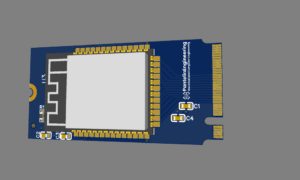Project Overview:
This custom development board is designed to streamline prototyping and testing for IoT applications, leveraging the ESP32-S3 microcontroller’s robust connectivity and low power capabilities. The standout feature of this board is its M.2 (M-key) interface, which simplifies maintenance and module replacement, making it ideal for iterative development and production environments.

System Components:
- Core Microcontroller:
- ESP32-S3-WROOM-1 or ESP32-S3R16 for dual-core processing, Wi-Fi 6, and Bluetooth 5.0 LE connectivity.
- Multiple GPIOs, including specialized pins for SPI, I2C, and PWM, to interface with a variety of peripherals.
- Power Management:
- Integrated 3.3V regulator with capacitors for stable power output.
- Compatibility with external power supplies or batteries, making it flexible for different use cases.
- Connectivity and Debugging:
- USB D+ and D- lines for easy programming and debugging.
- UART (TX/RX) pins available for serial communication.
- Interface Highlights:
- M.2 Key (M):
- High-density connector for plug-and-play module replacement.
- Supports fast and secure mounting and unmounting, making it ideal for modular IoT setups.
- Accessible pins via the M.2 interface for peripherals like I2C, SPI, UART, and PWM.
- M.2 Key (M):
- Compact Design:
- Small form factor thanks to the M.2 standard, making it suitable for tight spaces.
- Designed for easy integration into prototype boards or enclosures.
- Peripheral Support:
- Includes pins for advanced sensors and actuators (e.g., SPI flash memory, I2C peripherals).
- Allows PWM control for motors, LEDs, and other dynamic components.
- Reset and Strapping:
- Onboard strapping pins and reset buttons ensure developers can easily configure boot modes and debug the microcontroller.
Key Benefits:
- Ease of Maintenance:
- M.2 module design simplifies hardware replacements and upgrades without soldering or reassembly.
- Rapid Prototyping:
- Developers can quickly swap out ESP32 modules for troubleshooting or upgrading to different ESP32-S3 versions.
- Scalability:
- The modular approach supports scaling up from prototyping to production without reengineering the PCB layout.
- Flexibility:
- Compatible with a wide array of sensors, actuators, and external components, allowing for diverse IoT applications.
- Durability and Longevity:
- The M.2 interface provides secure connections and minimizes wear and tear during frequent testing cycles.
Applications:
- IoT Prototyping: Ideal for developers needing a modular and easily replaceable design.
- Smart Devices: Suited for creating smart appliances, environmental monitors, or industrial IoT devices.
- Educational Use: Simplifies hardware learning with its plug-and-play architecture.
This development board bridges the gap between convenience and functionality, empowering developers to innovate quickly while maintaining high reliability. It represents a significant step forward in modular IoT design, fostering creativity and efficiency in the development process.
- Date: November 25, 2024
- Categories: PCB Layout and Design
- Project Files GITHUB
